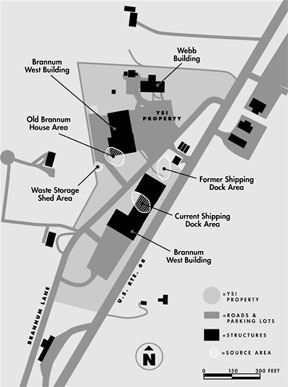                                                |
|
 |
|
|
Consultants
show soil source areas on YSI Inc.’s property
The search that YSI Incorporated began last October to locate the source
area of the contamination on its Brannum Lane property has finally yielded
results, a team of consultants from BHE Environmental, Inc. reported at
a public meeting Thursday, March 27.
After six months and three rounds of soil and groundwater testing, YSI
concluded that the soil in four areas, around the southwest corner of
the Old Brannum House, a waste storage shed and former and current shipping
dock areas on its property, were the cause of the toxic chemicals leaching
into the earth and contaminating the groundwater in the area. Though contamination
was found throughout the property, it is most concentrated in those four
areas, which YSI calls the source area of contamination.
The results were close to what internal investigators had expected in
2001 when toxic chemicals were discovered in several wells on YSI’s
property and on neighboring residential properties, according to Lisa
Abel, the YSI investigation project leader.
“Based on discussions with employees on past habits and past practices,
there were no surprises,” she said.
The contamination was partly due to toxic waste materials illegally dumped
in the late 1980s and early 1990s on the company’s property. The
Ohio Environmental Protection Agency has been working with YSI through
an administrative order to first eliminate exposure to contaminated groundwater
and then to clean up the source areas in the soil.
As part of the legal agreement, YSI was charged with supplying an alternative
source of water for nearby residents whose wells were contaminated or
in danger of becoming contaminated. YSI worked with the Village to provide
municipal water to those neighbors who wanted it. The Village finished
extending water lines to neighboring properties in January, and according
to the Village utility billing department, so far the Springs Motel, two
residents on U.S. 68, one on Golden Willow Court and one on Brannum Lane,
are using Yellow Springs water.
A comprehensive report on the newly identified source areas and potential
cleanup measures will be released for public comment on May 5, according
to Eric Riechert, director of site assessments for BHE.
“We think we have a good handle on the depth and width of the source
area,” he said. “The next report concerns where is the contamination
in the soil that might affect the groundwater.”
The contaminants in the source area, are the same seven that were identified
in earlier soil and water samples taken by YSI and the Ohio EPA in 2001
and 2002: 1,1-dichloroethane, 1,1-dichlorothene, 1,1,1-trichloroethane
(TCA), carbon tetrachloride, tetrachloroethene, chloroform and 1,4-dioxane.
Of these chemicals, only TCA was found to be at or above safe levels for
soil and groundwater at the Old Brannum House area and at the current
dock area, Abel said.
The investigation ruled out as source areas the Webb Building on the north
end of the property and an area near the northwest corner of the campus.
The only chemical previously found in the groundwater in three neighboring
residential wells to be above the accepting limits for drinking water
was 1,1-dichloroethene.
The remediation methods that YSI will consider, according to a preliminary
report from BHE, include several soil treatment options as well as containment
and removal of contaminated soils. “Simple” and “quick”
precautions include instituting restrictions to limit human contact with
contaminated areas and possibly capping or sealing off the area from exposure,
according to Riechert.
Removing the source areas would address the contamination directly, but
excavating soils from underneath existing buildings can be difficult and
may not be the best option, Riechert said. He discussed three methods
for treating the soils on site; including vacuum extraction of volatile
vapors, incinerating the contaminants or using microorganisms to metabolize
the contaminants.
Abel said that YSI would likely use a combination of soil remediation
methods, utilizing specific actions that would best address the contamination
of specific areas. Cleanup could possibly begin by late summer, Abel said,
after the official source area report is returned to YSI with comment
from the public and from the Ohio EPA.
In the meantime, YSI continues to conduct groundwater testing off its
property to determine the extent of the contamination plume. A report
on the extent of the plume should also be ready by the end of the summer,
Abel said.
—Lauren Heaton
|



